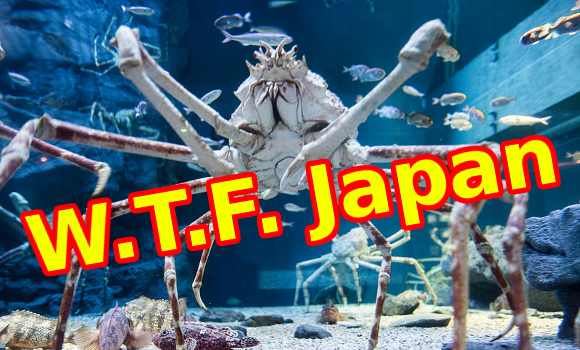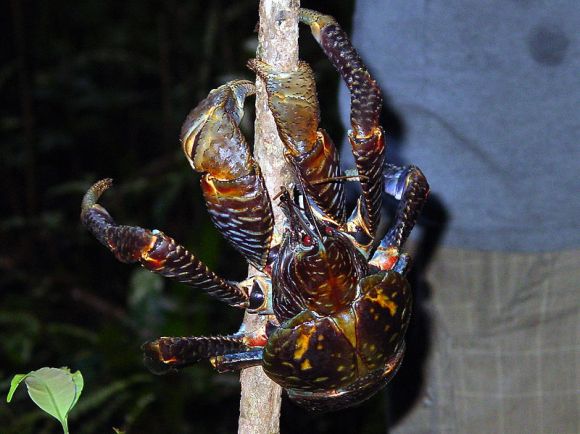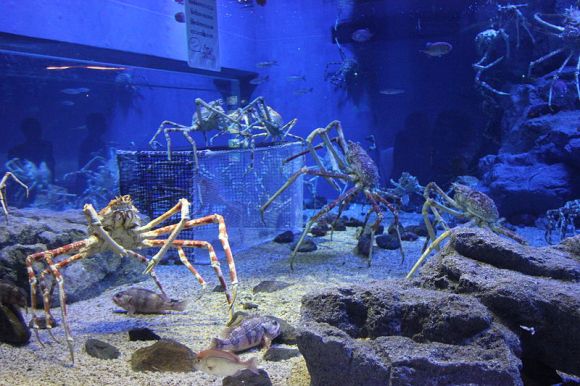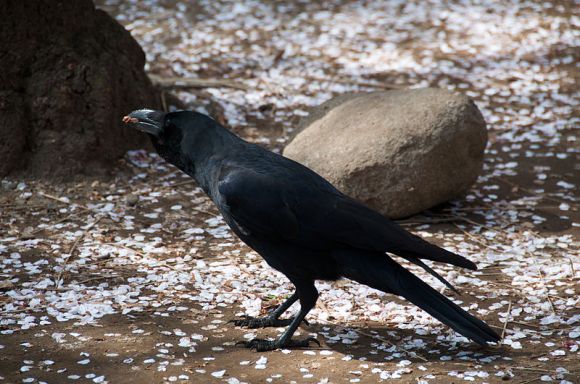
Why, Japan?! Why do such horrifying things have to live inside you?
Japan may be known as the land of cute things, but beneath the surface of big eyes and round faces lies the terrible truth: Japan is home to some of the scariest animals on the planet.
And that’s why today we’re counting down the top five creepiest Japanese animals. No insects on this list, since they would probably take up all five slots by themselves, but don’t worry, we’ll get to those terrifying beings eventually.
But anyway, let’s get started with…
#5. Spider crabs
You know what’s scary? Spiders. You know what else is scary? Crabs. Hey, you know what we should never ever do? Combine the two, that’s what!
Unfortunately Mother Nature had other ideas when she created the Japanese Spider crab (known as taka’ashigani in Japanese, literally “tall-legged crab”). These guy are the largest arthropods on Earth, with legs over three feet (one meter) long, resulting in a full leg span of over 12 feet (3.8 meters). Because nothing says “I love you” quite like a 12-foot-long, eight-legged crab hug. Shudder.
The reason these guys are only at number five is because they’re actually quite docile despite their monster-like appearance. They prefer to blend in to the bottom of the ocean floor by covering themselves with sponges and other sea animals, consuming basically whatever they can find.
Still, we’d rather not take our chances meeting one in person. These guys are found off the southern coasts of Honshu, the main Japanese island, so we recommend staying out of the ocean there. And pretty much anywhere in Japan. In fact, while you’re at it, just don’t go swimming anywhere except in kiddie pools.
▼ If you absolutely must see one of these things for yourself,
then you can do so at the Osaka Aquarium. Those legs… those legs….
#4. Goblin sharks
ミツクリザメって鼻が長いww pic.twitter.com/U6mxFzkvFZ
— 【きもすぎ】深海魚bot 【ワロタw】 (@shinkaigyogazou) June 24, 2016
If you weren’t put off by swimming in Japan’s oceans just yet, now’s your chance! Say hello to the Goblin Shark, known in Japanese as mitsukurizame or tenguzame with tengu being a mythical creature with a long nose. These guys are the result of what we’re guessing happened when the Shark Gods got drunk together one night and pulled a prank that suddenly spiraled out of control.
Goblin sharks are found outside of Japan as well, but Japan has the most cases of actually catching them, usually by accident. They live deep below the ocean surface, as far down as 4,000 feet (1200 meters), and can grow up to 20 feet (6.2 meters) and 460 pounds (210 kilograms).
Sure, that may not be Great White size, but that doesn’t matter because the intimidation factor is off the charts here. Just look at those jagged, barbed-wire-like teeth, the sawblade-like nose, and the eyes of a madman who can’t be reasoned with. These guys are literally “living fossils,” the last members of an ancient lineage dating back 125 million years that still retains the same “primitive” traits.
▼ But whatever you do, don’t say that to its face.
https://twitter.com/shingo20010101/status/724196156499062785#3. Giant salamanders
Salamanders aren’t usually so bad, just some slippery little dudes that climb up walls and eat pests. The problem arises, however, when the salamanders are suddenly six feet (1.9 meters) long.
Japan and China’s Giant Salamanders (oosansho’uo in Japanese) are the largest Amphibians in the world. They typically spend their time in the rivers of northern Kyushu and western Honshu (yet another reason to never go in the water), blending in with stones and mud so they can catch and eat basically anything that comes by: insects, fish, mice, crabs, hopes and dreams, pretty much anything.
They also cover their skin in mucus, which acts like a thin shield against scrapes and parasites. Their first act of self-defense is producing a milky, sticky secretion, making it not only one of the creepiest things we’ve ever seen, but one of the grossest as well.
▼ Here’s one in motion. Sure, it may look harmless outside the water, but in it,
you’re just one wrong step away from a mucus-covered nightmare.
#2. Coconut crabs

Sunny, tropical Okinawa. Ahh, beautiful beaches, sunny weather, and… OH MY GOD MONSTER CRABS!
Coconut crabs (known as yashigani in Japanese) may have a silly name, but not once you know the meaning behind it: they got their name because their claws are strong enough to crack open a coconut. Yeah, you heard that right. You know, coconuts, those things we humans require a hammer, a screwdriver, and a lot of screaming to open? These monstrosities can smash open no problem. Now just replace that coconut with your skull, and you see where the scary factor comes in.
These things are not only the largest land-living arthropods in the world, but the largest land-living invertebrates in the world too. With a leg span of up to 3 feet (0.9 meters) and weighing up to 9 pounds (4 kilograms), it’s no wonder that they have no natural predators, aside from humans and other coconut crabs.
Just in case you weren’t terrified yet, here’s some pictures:
▼ I think I my spine just shivered itself out of my body.
Fence off your yard, and start a coconut crab ranch! pic.twitter.com/S2Dv4vLE4R
— Valhalla DSP (@valhalladsp) July 24, 2016
▼ Did we mention they climb trees too?
https://twitter.com/llunapii/status/757058542289420288▼ Yup, trees are no longer safe either.
Cross them off the list along with water!
▼ Dog, what are you doing?! Run while you still can!
https://twitter.com/DanielGennaoui/status/749202242000064512▼ Welp, I guess I’m not doing the trash today!
https://twitter.com/gillie__beans/status/748022833368997890▼ The coconut crab’s claw strength in action, easily crushing pens.
That may not sound impressive, but try crushing a pen yourself. It’s hard.
▼ It turns out coconut crabs are really fast too. So we’re screwed in water,
trees, and on land too. That only leaves one safe place: the sky. Right…?
And the #1 creepiest Japanese animal is…
.
.
.
.
.
.
.
.
.
.
1. The motherf*&%ing scary as $h#! crows
If you thought the sky was safe, think again. In Japan, the sky and pretty much everything beneath it belongs to the crows.
Now you’re probably thinking: “Silly little crows? Oh come on, they’re not scary at all!” We’re not talking about any “silly little crows” here. We’re talking about Japanese crows (known as karasu), 2 foot (0.6 meter) long intimidation machines found all over Japan that don’t rely on just their appearance and shrill call to horrify passerby, but their terrifyingly high level of intelligence as well.
▼ These crows are the infamous ones who not only figured out how to use
moving cars to crack nuts, but also the stoplights to pick up the bits safely too.
In Japan, it’s not uncommon to hear about “crow attacks,” crows swooping from the sky to peck somebody’s head who never heard it coming. Whether the person is just out walking, riding a bike, or taking out the trash, getting attacked by a crow or group of crows is something to be prepared for whenever you hear caw caw.
And that’s the creepiest thing about the crows, which makes them number one on the list. The other animals may look scarier, but they’re usually perfectly happy to leave you alone. But not crows. They’ll watch you, think about you, and then do whatever they want, whenever they want. Maybe they’ll steal your food. Maybe they’ll whack you on the head. Maybe they…won’t do anything. We are all at their mercy.
▼ In Japan, crows are public enemy number one,
and it’s because of them that almost all garbage has to be secured in nets.
▼ Video footage of some crow attacks,
proving that crows are possibly nature’s greatest trolls.
So there you have it, the top five creepiest Japanese animals. Did we miss a Japanese animal that gives you nightmares? Let us know in the comments, so that we can all add more to our list of unsafe places.
References: Wikipedia (1, 2, 3, 4, 5), Smithsonian Institution
Featured/top image: Wikimedia Commons (Edited by RocketNews24)
In the meantime, follow me on Twitter and let me know if there’s any topics you’d like to see covered on W.T.F. Japan. See you next week!



 W.T.F. Japan: Top 5 creepiest Japanese insects 【Weird Top Five】
W.T.F. Japan: Top 5 creepiest Japanese insects 【Weird Top Five】 W.T.F. Japan: Top 5 biggest Japanese food challenges【Weird Top Five】
W.T.F. Japan: Top 5 biggest Japanese food challenges【Weird Top Five】 W.T.F. Japan: Top 5 most annoying sounds in Japan 【Weird Top Five】
W.T.F. Japan: Top 5 most annoying sounds in Japan 【Weird Top Five】 W.T.F. Japan: Top 5 nicest sounds in Japan【Weird Top Five】
W.T.F. Japan: Top 5 nicest sounds in Japan【Weird Top Five】 W.T.F. Japan: Top 5 best Tamagotchi releases 【Weird Top Five】
W.T.F. Japan: Top 5 best Tamagotchi releases 【Weird Top Five】 Private booths are coming to Japan’s Shinkansen bullet trains even sooner than we’d thought【Video】
Private booths are coming to Japan’s Shinkansen bullet trains even sooner than we’d thought【Video】 The Purple Lucky Bag from Village Vanguard is an extra-large waste of money
The Purple Lucky Bag from Village Vanguard is an extra-large waste of money Japanese beef bowl chain Sukiya’s 2026 Smile Box lucky bag basically pays for itself
Japanese beef bowl chain Sukiya’s 2026 Smile Box lucky bag basically pays for itself Dragon Quest Burgers and Slime drinks are coming to McDonald’s Japan【Video】
Dragon Quest Burgers and Slime drinks are coming to McDonald’s Japan【Video】 Harajuku’s new permanent Tamagotchi shop is filled with cuteness and a surprising lack of poop
Harajuku’s new permanent Tamagotchi shop is filled with cuteness and a surprising lack of poop Majority of Japanese mayors say foreign residents are essential but most see good and bad effects
Majority of Japanese mayors say foreign residents are essential but most see good and bad effects Nephew receives SD card after his uncle passes away, finds treasure trove of gems from the past
Nephew receives SD card after his uncle passes away, finds treasure trove of gems from the past New Japanese menstrual product seeks to help women spot unidentified iron deficiencies
New Japanese menstrual product seeks to help women spot unidentified iron deficiencies Brand-new Pokémon park opens in Japan with larger-than-life-size Lapras【Photos】
Brand-new Pokémon park opens in Japan with larger-than-life-size Lapras【Photos】 Our top 3 cafes in Azabudai Hills, Tokyo’s newest and possibly swankiest shopping complex
Our top 3 cafes in Azabudai Hills, Tokyo’s newest and possibly swankiest shopping complex Starbucks Japan ready to get Year of the Horse started with adorable drinkware and plushies【Pics】
Starbucks Japan ready to get Year of the Horse started with adorable drinkware and plushies【Pics】 Hayao Miyazaki says Happy New Year to Studio Ghibli fans with new art for Year of the Horse
Hayao Miyazaki says Happy New Year to Studio Ghibli fans with new art for Year of the Horse We found possibly the quietest Japanese-style hotel in Tokyo’s bustling Shinjuku district
We found possibly the quietest Japanese-style hotel in Tokyo’s bustling Shinjuku district Cup Noodle tries an authentic Jiro-style ramen, but something’s not quite right
Cup Noodle tries an authentic Jiro-style ramen, but something’s not quite right The best Starbucks Japan Frappuccinos we want to drink again in 2026
The best Starbucks Japan Frappuccinos we want to drink again in 2026 We revisited Sweets Paradise after a decade to see if Japan’s dessert buffet still delivers
We revisited Sweets Paradise after a decade to see if Japan’s dessert buffet still delivers That time Seiji called JASRAC to ask why he didn’t get paid royalties for his song being on TV
That time Seiji called JASRAC to ask why he didn’t get paid royalties for his song being on TV Japan’s oldest largetooth sawfish in captivity back on display in Mie Prefecture
Japan’s oldest largetooth sawfish in captivity back on display in Mie Prefecture Pizza Hut Japan’s hot lucky bags are perfect for a New Year’s pizza party
Pizza Hut Japan’s hot lucky bags are perfect for a New Year’s pizza party 7-Eleven Japan starts new temporary luggage storage service in over 300 branches
7-Eleven Japan starts new temporary luggage storage service in over 300 branches Disillusionment at Tsukiji’s tourist-target prices led us to a great ramen restaurant in Tokyo
Disillusionment at Tsukiji’s tourist-target prices led us to a great ramen restaurant in Tokyo Starbucks teams up with 166-year-old Kyoto doll maker for Year of the Horse decorations【Photos】
Starbucks teams up with 166-year-old Kyoto doll maker for Year of the Horse decorations【Photos】 Tokyo considering law requiring more trash cans following litter increase in heavily touristed area
Tokyo considering law requiring more trash cans following litter increase in heavily touristed area Tokyo’s Tsukiji sushi neighborhood asks tour groups to stay away for the rest of the month
Tokyo’s Tsukiji sushi neighborhood asks tour groups to stay away for the rest of the month Tokyo event lets you travel back in time, for free, to celebrate 100 years since Showa era start
Tokyo event lets you travel back in time, for free, to celebrate 100 years since Showa era start Japan may add Japanese language proficiency, lifestyle classes to permanent foreign resident requirements
Japan may add Japanese language proficiency, lifestyle classes to permanent foreign resident requirements Sanrio theme park in Japan announces plans to expand into a Sanrio resort
Sanrio theme park in Japan announces plans to expand into a Sanrio resort Stamina-destroying “Paralysis Noodles” are Tokyo’s newest over-the-top ramen innovation
Stamina-destroying “Paralysis Noodles” are Tokyo’s newest over-the-top ramen innovation Survey asks foreign tourists what bothered them in Japan, more than half gave same answer
Survey asks foreign tourists what bothered them in Japan, more than half gave same answer Japan’s human washing machines will go on sale to general public, demos to be held in Tokyo
Japan’s human washing machines will go on sale to general public, demos to be held in Tokyo Japan’s deadliest food claims more victims, but why do people keep eating it for New Year’s?
Japan’s deadliest food claims more victims, but why do people keep eating it for New Year’s? We deeply regret going into this tunnel on our walk in the mountains of Japan
We deeply regret going into this tunnel on our walk in the mountains of Japan Studio Ghibli releases Kodama forest spirits from Princess Mononoke to light up your home
Studio Ghibli releases Kodama forest spirits from Princess Mononoke to light up your home Major Japanese hotel chain says reservations via overseas booking sites may not be valid
Major Japanese hotel chain says reservations via overseas booking sites may not be valid Put sesame oil in your coffee? Japanese maker says it’s the best way to start your day【Taste test】
Put sesame oil in your coffee? Japanese maker says it’s the best way to start your day【Taste test】 No more using real katana for tourism activities, Japan’s National Police Agency says
No more using real katana for tourism activities, Japan’s National Police Agency says Starbucks Japan reveals new sakura drinkware collection, inspired by evening cherry blossoms
Starbucks Japan reveals new sakura drinkware collection, inspired by evening cherry blossoms Updated cherry blossom forecast shows extra-long sakura season for Japan this year
Updated cherry blossom forecast shows extra-long sakura season for Japan this year W.T.F. Japan: Top 5 hardest Japanese habits to break 【Weird Top Five】
W.T.F. Japan: Top 5 hardest Japanese habits to break 【Weird Top Five】 W.T.F. Japan: Top 5 most hilarious Japanese euphemisms 【Weird Top Five】
W.T.F. Japan: Top 5 most hilarious Japanese euphemisms 【Weird Top Five】 W.T.F. Japan: Top 5 budget Japanese Halloween costumes 【Weird Top Five】
W.T.F. Japan: Top 5 budget Japanese Halloween costumes 【Weird Top Five】 W.T.F. Japan: Top 5 most confusing Japanese counter words【Weird Top Five】
W.T.F. Japan: Top 5 most confusing Japanese counter words【Weird Top Five】 W.T.F. Japan: The top five “sora” references of all time! 【Weird Top Five】
W.T.F. Japan: The top five “sora” references of all time! 【Weird Top Five】 W.T.F. Japan: One year anniversary special! Top 5 W.T.F. Japan articles 【Weird Top Five】
W.T.F. Japan: One year anniversary special! Top 5 W.T.F. Japan articles 【Weird Top Five】 W.T.F. Japan: Top 5 confusing Japanese Internet slang words 【Weird Top Five】
W.T.F. Japan: Top 5 confusing Japanese Internet slang words 【Weird Top Five】 W.T.F. Japan: Top 5 kanji with the longest readings 【Weird Top Five】
W.T.F. Japan: Top 5 kanji with the longest readings 【Weird Top Five】 W.T.F. Japan: Top 5 confusing Japanese hand gestures【Weird Top Five】
W.T.F. Japan: Top 5 confusing Japanese hand gestures【Weird Top Five】 W.T.F. Japan: Top 5 strangest Japanese home goods【Weird Top Five】
W.T.F. Japan: Top 5 strangest Japanese home goods【Weird Top Five】 W.T.F. Japan: Top 5 most famous pet dogs in Japan【Weird Top Five】
W.T.F. Japan: Top 5 most famous pet dogs in Japan【Weird Top Five】 W.T.F. Japan: Top 5 myths about learning Japanese【Weird Top Five】
W.T.F. Japan: Top 5 myths about learning Japanese【Weird Top Five】 W.T.F. Japan: Top 5 offensive Japanese insults【Weird Top Five】
W.T.F. Japan: Top 5 offensive Japanese insults【Weird Top Five】 W.T.F. Japan: Top 5 most ridiculous kanji handwriting shortcuts【Weird Top Five】
W.T.F. Japan: Top 5 most ridiculous kanji handwriting shortcuts【Weird Top Five】 W.T.F. Japan: Top 5 “shikata ga nai” (“it can’t be helped”) situations in Japan【Weird Top Five】
W.T.F. Japan: Top 5 “shikata ga nai” (“it can’t be helped”) situations in Japan【Weird Top Five】 W.T.F. Japan: Top 5 crazy things about Japanese supermarkets 【Weird Top Five】
W.T.F. Japan: Top 5 crazy things about Japanese supermarkets 【Weird Top Five】
Leave a Reply